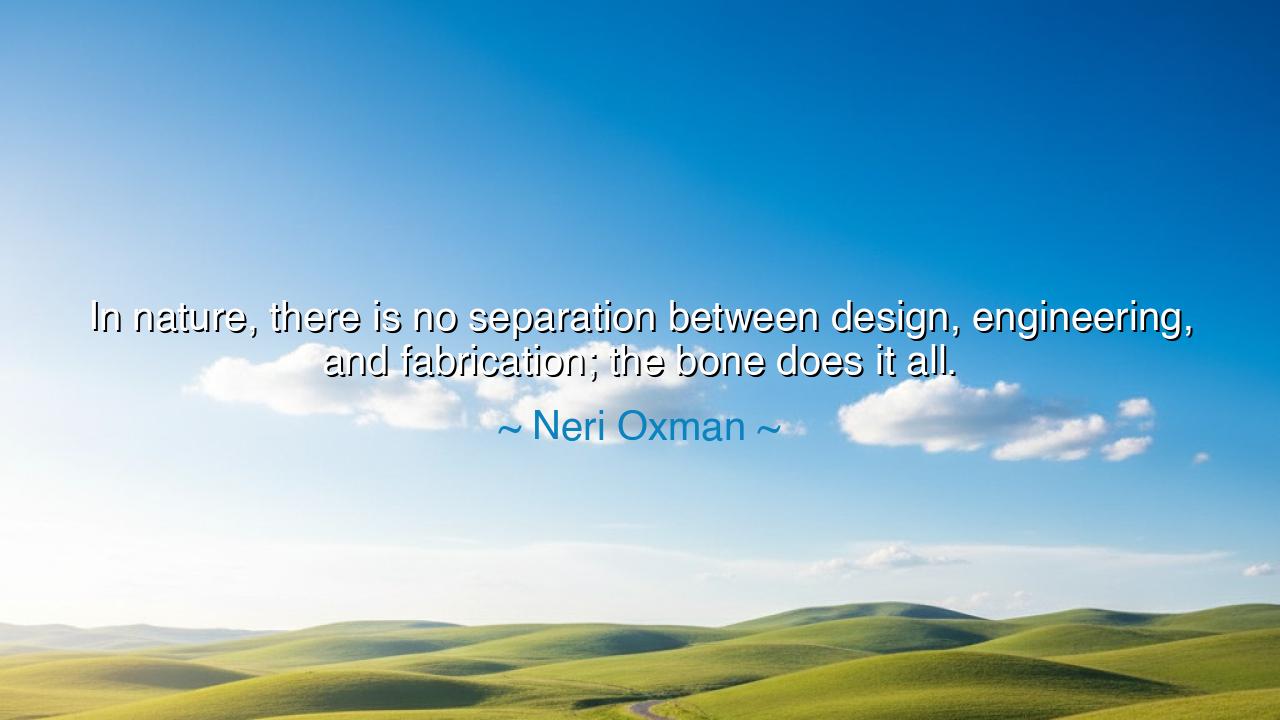
In nature, there is no separation between design, engineering
In nature, there is no separation between design, engineering, and fabrication; the bone does it all.






“In nature, there is no separation between design, engineering, and fabrication; the bone does it all.” — Neri Oxman
Listen, O seeker of wisdom and maker of things, to the voice of Neri Oxman, the architect of both science and spirit, who gazed into the fabric of life and found the truest teacher there—nature itself. When she declares that “the bone does it all,” she is not speaking only of anatomy, but of the divine unity that governs creation. For in the living world, there is no division between design, engineering, and fabrication. The tree does not plan before it grows; the shell does not separate architect from builder; the bone, quietly forming within the body, is its own designer, its own engineer, its own craftsman. Nature, in her eternal wisdom, is whole.
Oxman’s words rise from the field she herself shaped—material ecology, where biology and design intertwine. In her work at MIT, she studied how living systems grow, adapt, and build themselves without boundaries between idea and execution. She looked at the way bones grow denser where they bear weight, how a leaf thickens in the sun, how coral builds its home grain by grain—each one a perfect balance of function and beauty. And she saw in these examples a lesson for humankind: that we have divided what was once unified. We separate art from science, structure from spirit, thought from making—and in doing so, we have forgotten the way of life itself.
In the bone lies the parable of all design. A bone is not a cold mechanism; it is a living cathedral, constantly reshaping itself to the forces it endures. When a bone bears stress, it strengthens; when it rests, it lightens. There is no waste, no excess, no part without purpose. The bone does it all, because it must—and in doing so, it achieves perfection. It is the silent architect of the body, obeying no draftsman, following no blueprint but its own nature. In this, it shows us the path of true creation: not the assembly of parts, but the growth of wholeness.
Think of the builders of Gothic cathedrals, who once mirrored nature’s wisdom in stone. They did not separate art from structure—their buttresses, vaults, and spires were both beautiful and essential. The design was the engineering, and the engineering was the design. In their hands, stone became living matter; their work echoed the bone’s harmony, where every line was both strength and grace. Yet as time passed, the modern age split these sacred duties apart. The artist dreamed, the engineer calculated, the fabricator obeyed. The unity of creation was fractured, and we began to build things that stood—but did not live.
Oxman calls us to return to nature’s law. She urges the designer, the maker, the thinker, to look again at how the living world creates—not through division, but through synthesis. When the spider spins its web, the silk’s structure, form, and purpose are one. When the honeybee builds its hive, geometry, material, and intention are inseparable. This is the ancient secret of organic design—to weave function and form until they are indistinguishable. And so the wise creator learns not to command nature, but to collaborate with it, to shape as the bone shapes, guided by necessity and born from life itself.
The lesson, then, is profound: seek unity in your work. Whatever you build—be it a home, a poem, a life—let it be whole. Do not split your actions into compartments of logic and passion, mind and hand, vision and craft. Let your ideas grow naturally into their form, as the bone grows into strength. Observe nature’s way: it wastes nothing, fears no imperfection, and creates beauty through adaptation. Be like the bone—responsive, resilient, and integrated with the world around you.
So remember this teaching: the bone does it all, and so can you. Let your life become a single, living structure where thought and deed, art and necessity, merge in harmony. Do not design without soul, nor build without love, nor analyze without wonder. For the greatest art is that which breathes, and the greatest science is that which feels. Walk the path of unity, O maker, and you will find that every act of creation—when done in the spirit of nature—is not invention, but continuation. You are not apart from the world’s design; you are its living extension.






AAdministratorAdministrator
Welcome, honored guests. Please leave a comment, we will respond soon